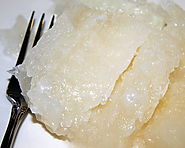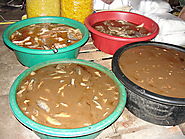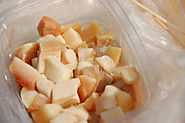-
About
- About Listly
- Community & Support
- Howto
- Chrome Extension
- Bookmarklet
- WordPress Plugin
- Listly Premium
- Privacy
- Terms
- DMCA Copyright
- © 2010-2025 Boomy Labs


 Joanna James
Joanna James
Listly by Joanna James
If you generally stay away from the 'weird' looking food, this isn't for you. However, if you're adventurous and like trying strange, new delicacies, keep reading! 🦑🦀🦐

By mdid (Flickr) CC BY 2.0, via Wikimedia Commons
This traditional Eskimo dish is not for the faint heart - the recipe requires you to cut off the head of a king salmon, before wrapping it in grass, and burying it in a pit for up to six weeks. After which, you dig up the rotten head and consume it.
Whilst the rotten smell may not be the most appetizing, it is said that the method of preparation makes the fish bones so soft that you can chew them. If you're wondering how they've managed to eat putrid fish without falling sick, the trick is in its preparation.
According to the traditional recipe, the fish ferments at cool temperatures. However, nowadays the entire process is fast-tracked by keeping the fish head in a closed bucket or ziplock bag.
While it rots the fish faster, it also creates a breeding ground for bacteria, which can make you dangerously ill. So if you plan on trying this out, make sure you know how it was made.

By Jonathunder (Own work) CC BY-SA 3.0 or GFDL, via Wikimedia Commons
What starts out as simple dried cod, Lutefisk goes through several months of preparation to create the jelly-like substance which is eaten during Christmas in Norway.
The dried cod is kept in water for a week, before being transferred to a mix of lye and water for a further week - if it's left too long in this mixture, the fish fat will turn into soap! After all this, the fish has doubled in size, has a jelly-like consistency and is actually cable of corrosion.
To avoid burning off your stomach lining, the fish is further soaked for a week, with the water changed daily to detoxify it. After all this, it's just a matter of steaming and eating, but don't eat it with silver utensils because the Lutefisk will corrode them!

By Lord Mountbatten (Own work) CC BY-SA 3.0, via Wikimedia Commons
A indispensable ingredient in Thai cooking, fish sauce is basically fermented fish juices. While it may not sound very pleasant, once you get past the idea of it, and the strong smell, it's actually tastes pretty good.
Fish sauce is made by placing fresh fish in barrels of salt water, that are then left in the sun for up to a year, to allow fermentation. The barrels are opened one in awhile to air out and give the juice its special aroma.
When the fish is fully decomposed, the fish juice is drained out and aired further to reduce its powerful aroma, before finally being bottled.
The process behind its creation may put many people off, but fish sauce lends a special touch to many dishes in Asia, some of which have been featured in travel blogs like Sandy Beach Trips.

By James Creegan from Manchester, UK (drunken shrimp Uploaded by tomchen1989) CC BY 2.0], via Wikimedia Commons
If the idea of eating rotten fish just doesn't excite you enough, try eating live shrimp. Be warned, your food may attack you in the process!
Generally found at seaside beach restaurants, drunken shrimp is basically live shrimp placed in a bowl of white wine, and then, well, eaten.
If you're not a fan of fighting your food to the death, the 'cooked version' involves lighting the alcohol on fire before dumping it on the shrimp.
Not sure which way is worse for the shrimp, but those you have had it say the taste is worth the macabre recipe. 🦐

Kæstur Hákarl , Photo by Audrey via (CC BY 2.0)
Prepared from Greenland sharks - this dish proves people will go through months of prep just to eat toxic food!
The sharks don't have a urinary tract so it secretes all the toxins through its skin, making it highly poisonous. To make it edible,the flesh is chopped and buried in the ground, and left for six weeks to several months in order for it to rot.
During this stage the deadly acids seep out of its skin. It is then hung up out of the sun to dry for more months to get rid of the smell. Once it's sufficiently dried, the brown outer skin is cut off to revel white flesh underneath which tastes like strong cheese with a dash of ammonia. 🦈

A true believer that the pen is a mighty weapon, ventures into reaching the minds of every reader with the earnest hope of leaving an indelible stream of thought.
A travel writer who has a passion for fashion and a deep interest in admiring new and exotic attractions around the world.